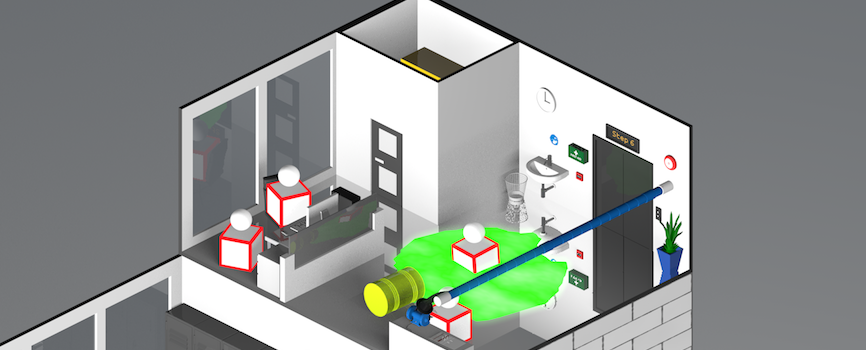Electrical safety on construction sites – everything you need to know
Posted 3 years ago

Electricity can be extremely dangerous. In fact, a six-year study by the HSE found that around 6% of all fatal injury accidents in Great Britain were as a result of contact with electricity.
You won’t be shocked to hear that electricity can be extremely dangerous (see what we did there).
Working with electricity presents a number of risks in any environment but particularly on a construction site where any hazards could potentially be on a much larger scale.
In fact, a six-year study by the HSE found that around 6% of all fatal injury accidents in Great Britain were as a result of contact with electricity.
Most accidents are a result of a lack of awareness, which is why it is essential that anyone who works on a construction site is aware of the risks and how they can avoid them.
With that said, we have put together this short guide surrounding electrical hazards on a construction site and what you can do to protect your staff, visitors and business.
What is electrical safety and why is it important on construction sites?
Electrical Safety is a set of practices, procedures and regulations that are set out to prevent electrical hazards in the workplace. On construction sites, where workers regularly use power tools, heavy machinery and temporary electrical setups, ensuring proper electrical safety is key to reducing the risk of factors such as electrocution, fires, and equipment damage.
Why is Electrical Safety Important on Construction sites
Construction sites are always high risk environments when it comes to electrical health and safety hazards due to factors such as exposed wiring, temporary power supplies and working near live electrical wires. Without proper precautions, electrical accidents can cause serious injuries, fatalities and costly project delays. Key reasons why electrical safety is essential include:
- Preventing Electrocution and Injury – Contact with live wires or faulty equipment can result in electric shocks, burns or even fatal injuries.
- Reducing Fire Risks – Poor Wiring, overloaded circuits or damaged cables can lead to electrical fires, endangering workers and equipment.
- Legal compliance – Construction businesses must comply with safety regulations such as the Electricity at Work Regulations 1989 to protect workers and avoid legal consequences.
- Maintaining productivity – Electrical incidents can lead to site shutdowns, delays, and costly repairs, affecting project timelines.
By following electrical safety protocols, construction workers and site managers can create a safer working environment while ensuring compliance with industry regulations – it’s a win-win!
Common electrical safety hazards on construction sites
Electrical hazards are a significant risk on construction sites, where workers often operate in environments with exposed wiring, temporary power supplies, and high-powered machinery. Each construction site presents unique risks, which is why a thorough risk assessment must be carried out before work begins. However, certain electrical hazards are prevalent across most sites and, if not properly managed, can result in serious injuries, fatalities, or costly delays. From overhead and underground power lines to faulty wiring and improper grounding, understanding these dangers is crucial for maintaining a safe working environment.
Electrical equipment and machinery
Construction workers will almost always have to use some sort of electrical equipment on site as part of their role. This could be anything from a hand-held tool to a large piece of machinery.
Those required to use electrical equipment must be provided with sufficient information and training on how to safely operate it, as part of the Provision and Use of Work Equipment Regulations (PUWER) 1998.
Overhead power lines
With the HSE estimating that over 50% of fatal electrical accidents are caused by contact with overhead power lines, this is one of the key risks to look out for.
Most of these accidents are either due to a lack of awareness or an inadequate risk assessment. This highlights the importance of conducting a thorough risk assessment before starting work.
It is best to avoid working near overhead power lines altogether. However, if you must carry out work near overhead power lines, then it is crucial that you follow precautions. This could include consulting the local electricity company on how to safely proceed or even requesting that the power lines are switched off before work.
Underground power cables
Underground power cables are arguably more dangerous than overhead ones due to the fact they often aren’t visible. Additionally, it can be impossible to tell whether the cables are live when uncovered. With that said, extra care needs to be taken when carrying out digging operations on site, particularly if the site is near buildings or residential areas.
If digging operations are required, similar steps should be taken to deal with overhead power lines. Consult your local electricity company and council for up-to-date maps on buried services. Using this guidance, you should be able to create an adequate risk assessment.
Improper grounding and faulty wiring
Faulty wiring is a key electrical hazard on a construction site. This is particularly true when wiring is being installed in close proximity to flammable materials.
To minimise this risk, it is crucial that all wiring is installed and tested by a qualified electrician. Additionally, proper grounding procedures must be followed to prevent any electrical shocks.
Emerging electrical safety risks in modern construction
As construction sites continue to evolve with new technologies and practices, so do the electrical hazards that workers face. While traditional risks like exposed wiring and faulty equipment remain a concern, modern construction introduces additional safety challenges that need to be addressed.
- Battery-powered tools and equipment
Cordless tools have become increasingly popular due to their convenience and flexibility. However, they also bring new risks, such as:
- Battery fires and explosions – Lithium-ion batteries, commonly used in power tools, can overheat and catch fire if damaged or improperly stored.
- Electrical shocks – If battery packs are faulty or not maintained correctly, they can cause electrical faults that pose a risk to users.
- Charging station hazards – Poorly managed charging areas with multiple tools plugged in can lead to overloaded circuits and fire risks.
- Temporary site electrics
Construction sites often rely on temporary power supplies to operate lighting, tools, and machinery. These systems can be dangerous if not set up and maintained correctly. Risks include:
- Improper grounding – Temporary electrical setups may lack proper grounding, increasing the risk of shocks.
- Exposed cables – Cables running across sites can become trip hazards or suffer damage from heavy machinery.
- Weather-related risks – Outdoor electrical installations are vulnerable to rain, wind, and extreme temperatures, which can lead to electrical failures or short circuits.
- Increased use of smart technology and automation
As construction sites adopt smart technology, new risks are emerging:
- Untrained workers handling electrical automation – If workers are unfamiliar with how to operate or troubleshoot electrical automation systems, mistakes can lead to accidents.
- Cybersecurity threats affecting electrical systems – Modern construction sites rely on digital monitoring and control systems, which, if hacked or malfunctioning, could lead to electrical failures.
How can electrical safety hazards be prevented on a construction site?
Preventing electrical hazards on a construction site starts long before work begins. Thorough planning, proper training, and strict safety protocols are essential to minimising risks and ensuring a safe working environment. Employers and site operators must take proactive steps to identify potential electrical dangers, implement control measures, and educate workers on best practices.
From conducting detailed risk assessments to providing up-to-date electrical service maps and enforcing safe systems of work, every precaution plays a crucial role in reducing accidents and ensuring compliance with health and safety regulations.
Risk assessments
By law, a risk assessment must be carried out before work on a construction site begins. In this risk assessment, the person in charge must identify all potential electrical hazards and ensure that suitable control measures are in place to prevent them from causing an accident.
Employees should be familiarised with the risk assessment before they start work so they have a strong understanding of the key electrical hazards on construction sites.
Electrical services maps
Before the risk assessment, the site operator should have requested an up-to-date map from the local council that details any potentially dangerous electrical hazards like cables and wires in the area of work.
Similarly to the risk assessment, employees should be given the opportunity to familiarise themselves with this map before starting any work.
Safe systems of work
If a person’s role requires them to work directly or near to live electricity, then it is crucial that they are provided with the correct information and training to carry out their work safely.
The employer must set out a safe system of work (SSoW) that specifies the competence, skills, and knowledge required to safely perform these tasks.
Before beginning this job, it is essential that everyone involved is familiar with the SSoW document and have taken on board all the information and training provided.
Key Electrical Safety Best Practices for Workers
Electrical safety on construction sites isn’t just down to site managers—every worker plays a part in preventing accidents. Hazards like electric shocks, fires, and arc flashes can cause serious injuries, but by following best practices, you can help keep yourself and your team safe.
Only use equipment you’re trained to handle
Electrical work should always be left to trained professionals. If you’re not qualified to repair, install, or modify electrical systems, don’t attempt it. Even if something seems like a quick fix, using equipment you’re unfamiliar with can put you and others at risk. If you’re ever unsure, ask for guidance before getting started.
Wear the right PPE for the job
Personal protective equipment (PPE) is essential when working with electricity. It helps minimise the risk of injury if something goes wrong. Key PPE includes:
- Insulated gloves – These protect your hands from electric shocks but need regular checks for damage. A small tear can make them ineffective.
- Rubber-soled safety boots – These help insulate you from electrical currents, which is especially important if you’re working in wet conditions.
- Flame-resistant clothing – This protects against burns from electrical arcs and sparks.
- Face shields and safety goggles – Your eyes and face need protection from arc flashes and flying debris.
Wearing the right PPE—and keeping it in good condition—can make a huge difference in preventing injuries.
Lockout/Tagout (LOTO) to prevent accidental energisation
Lockout/Tagout (LOTO) procedures are in place to stop electrical systems from being accidentally switched on during maintenance or repairs. Here’s how they work:
- Shut down the power – Before starting any work, make sure the equipment is switched off and completely disconnected.
- Lock it out – Attach a physical lock to switches or circuit breakers to stop them from being turned back on.
- Tag it out – Add a warning tag that shows who locked it and why.
- Double-check – Always confirm that the system is fully de-energised before starting work.
- Keep control – Only the person who applied the lock should remove it once the job is done and it’s safe to restore power.
Following LOTO procedures properly can prevent life-threatening accidents.
By sticking to these safety measures—knowing your limits, wearing the right PPE, and following LOTO—you can help create a safer working environment for everyone on site.
What to do in an electrical emergency on site
Electrical emergencies on construction sites can escalate quickly, posing serious risks to workers and bystanders. Knowing how to respond effectively can prevent injuries, reduce damage and even save lives. Here’s what to do in different types of electrical emergencies:
Electric shock or electrocution
If someone receives an electric shock:
- Do not touch them directly – The person may still have contact with the electrical source, which means you could also get shocked.
- Shut off the power – if possible, find the power source and shut it off immediately to prevent anyone else from getting injured.
- Use a non-conductive object – If the power can’t be turned off, use an object like a wooden spoon or something covered in rubber to break the person’s contact with the electricity.
- Call the emergency services immediately – Dial 999 (or your country’s equivalent) to get an ambulance to the site immediately, so the person can get medical treatment as soon as possible.
- Perform CPR if needed – If the person is unresponsive and not breathing, start CPR until medical help arrives.
Electrical fires
Electrical fires require special handling because using water can worsen the situation. If an electrical fire breaks out:
- Cut the power – Shut off electricity to the affected areas if safe to do so.
- Use a class C or CO2 fire extinguisher – Never use water on an electrical fire, as it conducts electricity and may cause the fire to spread further.
- Evacuate the area – If the fire cannot be controlled, alert all workers and evacuate to a safe location.
- Call 999 – Call the emergency services and provide details about the fire so they can find the best course of action.
Overhead & underground power line contact
If machinery or equipment comes into contact with overhead or underground power lines:
- Stay inside the vehicle or machinery – If you’re operating the equipment, do not attempt to leave unless absolutely necessary (e.g., in case of fire).
- Warn others to stay back – Anyone approaching the equipment risks electric shock.
- Call for emergency assistance – Report the incident immediately and wait for trained professionals to handle the situation.
- Exit safely if required – If staying inside is unsafe, jump clear with both feet together, avoiding contact with the ground and equipment at the same time, or you can shuffle away with small steps to reduce electrical shock risk.
Electrical equipment malfunctions
If electrical tools or equipment start sparking, overheating or making unusual noises:
- Stop using the equipment immediately and switch it off.
- Disconnect from the power supply if it is safe to do so.
- Report the issue to a supervisor or site manager.
- Do not attempt repairs unless you are a qualified electrician.
After any electrical emergency, you should always report and document incidents in an accident booklet. Not only will this help ensure that you are keeping up to date with your health and safety regulations, but it will also help to determine the cause of the incident and put in preventative protocols, provide additional training or replace equipment to prevent future incidents.
Online electrical safety training
Taking into account the information above, it’s clear to see that electrical safety isn’t only an issue for electricians.
Here at iHasco, we offer an IOSH approved online Electrical Safety Training course that is designed for all levels of staff and offers practical advice and guidance for safety when working around electricity. Our Construction Training bundle contains Electrical Safety Training, as well as other essential courses such as Asbestos Awareness, PUWER & PPE Training. This ensures your construction workers have all the knowledge they need to stay safe on-site.
Claim a free, no-obligation trial to the course today!

Jack Rosier
Senior Marketing Executive
Related articles



Opt-in to our newsletter
Receive industry news & offers